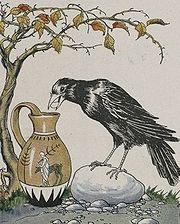
The Crow and the Pitcher
Encyclopedia

Aesop's Fables
Aesop's Fables or the Aesopica are a collection of fables credited to Aesop, a slave and story-teller believed to have lived in ancient Greece between 620 and 560 BCE. The fables remain a popular choice for moral education of children today...
, numbered 390 in the Perry Index
Perry Index
The Perry Index is a widely-used index of "Aesop's Fables" or "Aesopica", the fables credited to Aesop, the story-teller who lived in ancient Greece between 620 and 560 BC...
. It is found in the 2nd century CE Greek fable collection by pseudo-Dositheus, and later appears in the 4th–5th century Latin verse collection by Avianus
Avianus
Avianus, a Latin writer of fables, generally placed in the 5th century, and identified as a pagan.The 42 fables which bear his name are dedicated to a certain Theodosius, whose learning is spoken of in most flattering terms. He may possibly be Macrobius Ambrosius Theodosius, the author of...
. The history of this fable in antiquity and the Middle Ages is tracked in A.E. Wright's Hie lert uns der meister: Latin Commentary and the Germany Fable.
In the fable, a thirsty crow
Crow
Crows form the genus Corvus in the family Corvidae. Ranging in size from the relatively small pigeon-size jackdaws to the Common Raven of the Holarctic region and Thick-billed Raven of the highlands of Ethiopia, the 40 or so members of this genus occur on all temperate continents and several...
comes upon a pitcher
Pitcher (container)
A pitcher is a container with a spout used for storing and pouring contents which are liquid in form. Generally a pitcher also has a handle, which makes pouring easier.A ewer is a vase-shaped pitcher, often decorated, with a base and a flaring spout...
with water at the bottom, beyond the reach of its beak
Beak
The beak, bill or rostrum is an external anatomical structure of birds which is used for eating and for grooming, manipulating objects, killing prey, fighting, probing for food, courtship and feeding young...
. After failing to push over the pitcher, it drops in pebbles, one by one, until the water rises to the top of the pitcher, allowing the crow to drink. Avianus follows the fable with a moral
Moral
A moral is a message conveyed or a lesson to be learned from a story or event. The moral may be left to the hearer, reader or viewer to determine for themselves, or may be explicitly encapsulated in a maxim...
that emphasises the virtue
Virtue
Virtue is moral excellence. A virtue is a positive trait or quality subjectively deemed to be morally excellent and thus is valued as a foundation of principle and good moral being....
of ingenuity: "This fable shows us that thoughtfulness is superior to brute strength." Other tellers of the story stress the crow's persistence, while Francis Barlow
Francis Barlow (artist)
Francis Barlow was an English painter, etcher, and illustrator.-Life:Barlow's first major work was the illustration of Edward Benlowe's Theophila...
's edition concludes with the proverb "Necessity is the mother of invention.
In its earliest attestation in Pliny, this story is related of real-life corvids. More recently, a group of biologists at the Max Planck Institute for Evolutionary Anthropology
Max Planck Institute for Evolutionary Anthropology
The Max Planck Institute for Evolutionary Anthropology is a research institute based in Leipzig, Germany, founded in 1997. It is part of the Max Planck Society network....
has reported that orangutan
Orangutan
Orangutans are the only exclusively Asian genus of extant great ape. The largest living arboreal animals, they have proportionally longer arms than the other, more terrestrial, great apes. They are among the most intelligent primates and use a variety of sophisticated tools, also making sleeping...
s could retrieve peanut
Peanut
The peanut, or groundnut , is a species in the legume or "bean" family , so it is not a nut. The peanut was probably first cultivated in the valleys of Peru. It is an annual herbaceous plant growing tall...
s from plastic tubes by spitting water into them. The researchers were quoted as drawing a parallel between their findings and the fable. In August 2009, a study published in Current Biology
Current Biology
Current Biology is a scientific journal that covers all areas of biology, especially molecular biology, cell biology, genetics, neurobiology, ecology and evolutionary biology. The journal is published twice a month and includes peer-reviewed research articles, various types of review articles, as...
revealed that rooks
Rook (bird)
The Rook is a member of the Corvidae family in the passerine order of birds. Named by Carl Linnaeus in 1758, the species name frugilegus is Latin for "food-gathering"....
, a relative of crows, do just the same as the crow in the fable when presented with a similar situation.
The fable in the applied arts
Use of the fable may go back to Roman times, since one of the mosaics that has survived is thought to have the story of the crow and the pitcher as its subject. Modern equivalents have included English tiles from the 18th and 19th centuries and an American mural by Justin C. Gruelle (1889-1978), created for a Connecticut school. These and the illustrations in books of fables had little scope for invention. The greatest variation is in the type of vessel involved and over the centuries these have varied from a humble clay pot to elaborate Greek pitchers. More modern applications have included a rug and a card-game.External links
- 15th-20th century illustrations from books

